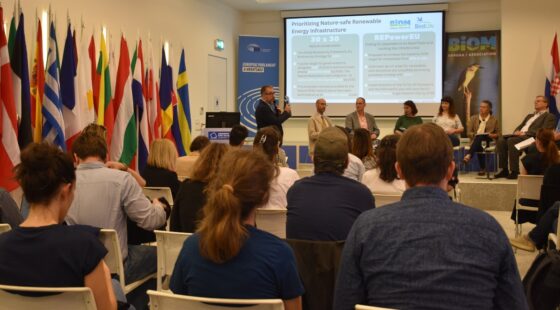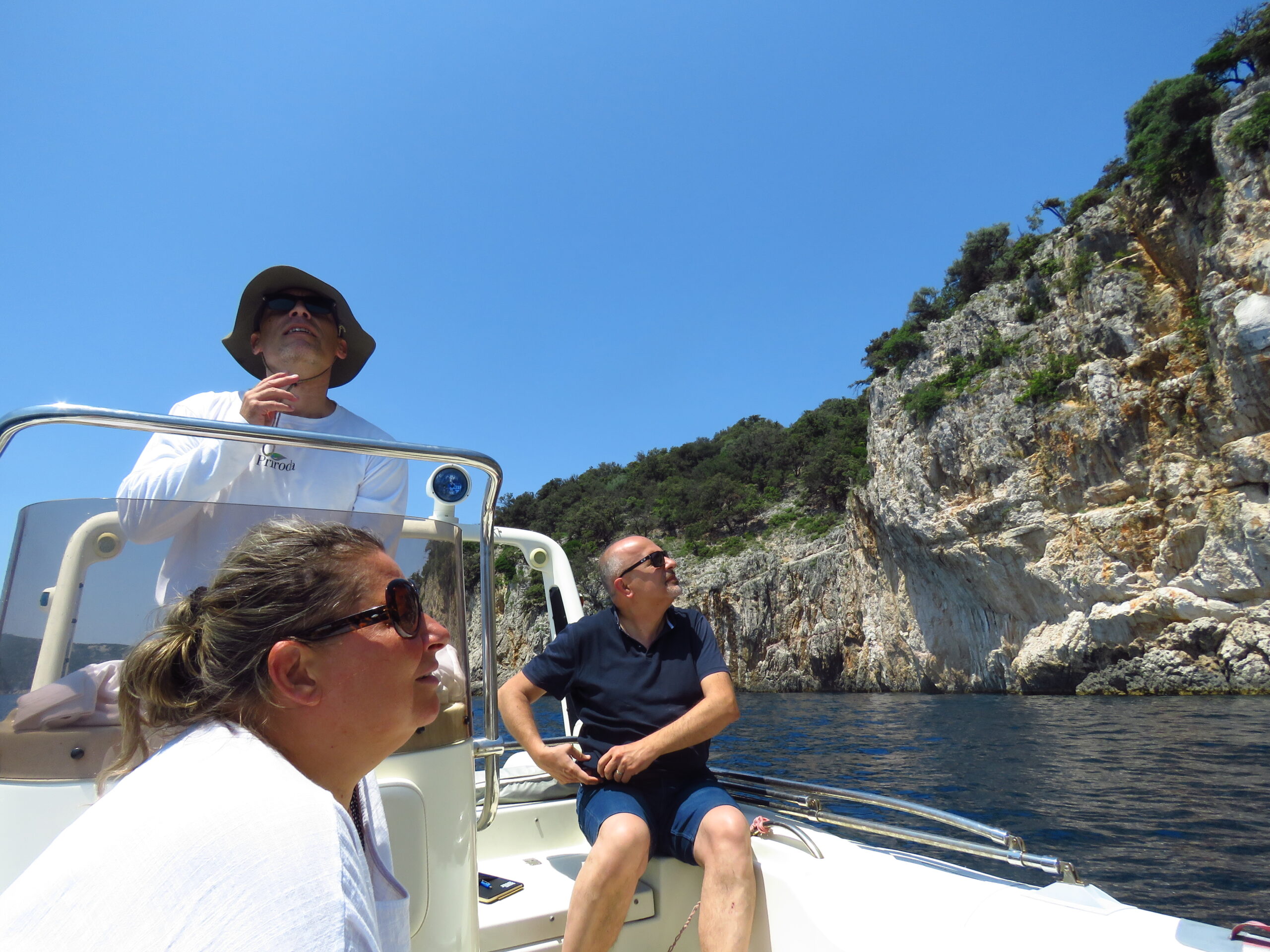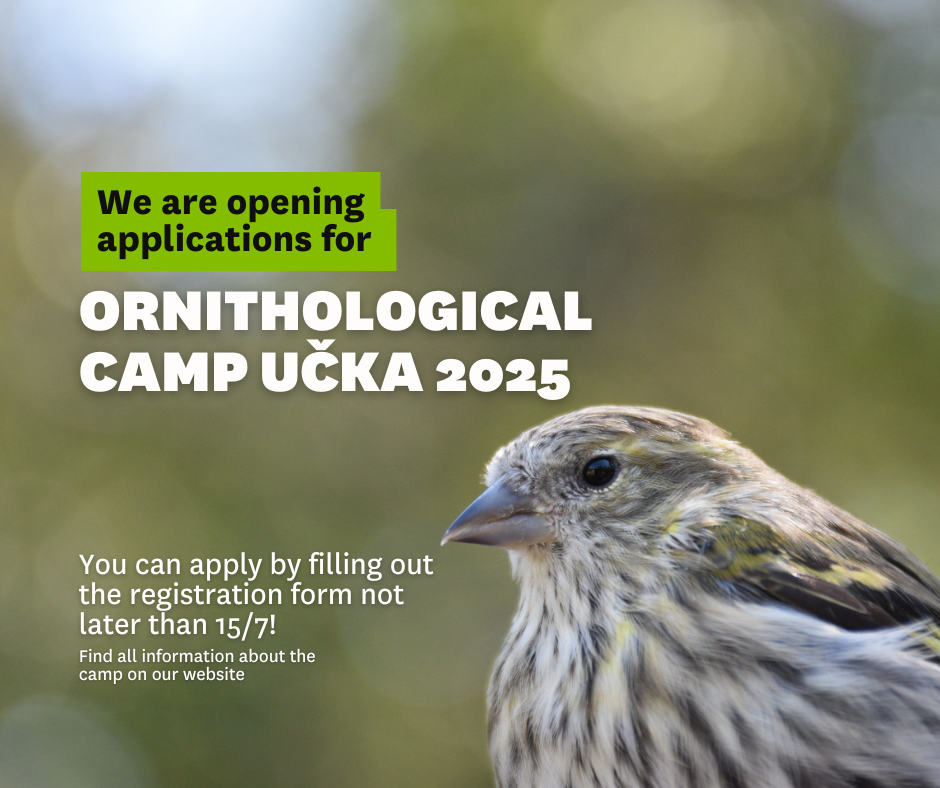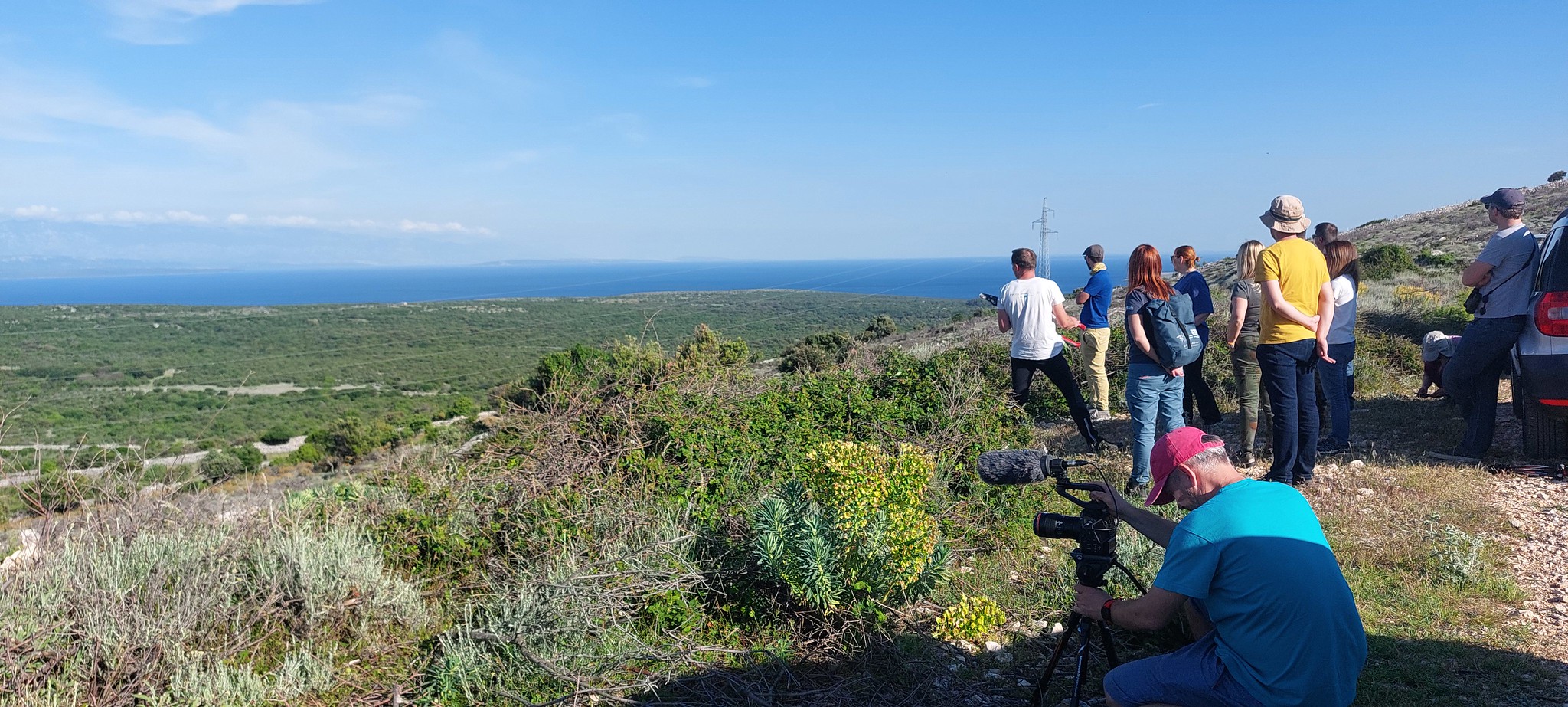Experts from two fields – nature conservation and development of renewable energy sources – gathered at the House of Europe in Zagreb on April 8th, emphasizing the need for good development planning and sensitivity mapping, transparency and involvement of stakeholders, and systematic collection of data on the presence of sensitive and endangered species.

The Global Framework for Biodiversity sets the goal of protecting at least 30 percent of land and sea by 2030. The updated EU Directive on energy from renewable sources increases the share of energy from renewable sources in the final energy consumption in the EU to 42.5% by 2030. EU member states should strive to achieve a share of 45%. Can these two goals – nature conservation and energy transition – go hand in hand? Is it possible to build an energy infrastructure that will not harm nature?
“It would be ideal to see good strategic planning that puts nature restoration and energy transition on the same level. And this should be done using scientific methods such as sensitivity mapping with the involvement of all relevant stakeholders. The problem is that we should already have taken that steps, and now we are trying to board a train that has already left. We don’t have ten years to plan anymore, to start construction only then, but we have to act quickly and ensure that we invest in nature and in energy at the same time”,
Ariel Brunner, director of BirdLife Europe and Central Asia, pointed out at the round table entitled “Prioritizing Nature-safe Renewable Energy Infrastructure” held on Monday, April 8, at the House of Europe in Zagreb.
The gathered experts from the fields of nature conservation and development of renewable energy sources emphasized that good development planning and sensitivity mapping, maintaining a high standard of development, transparency and involvement of stakeholders, as well as systematic collection of data on the presence of sensitive and endangered species are necessary.
Gabrijela Šestani, representative of the Ministry of Economy and Sustainable Development, head of the Nature Sector of the Institute for Environmental and Nature Protection, said that the European Green Plan, if we take into account the current state of the environment in the EU, is enormously ambitious from the point of view of the nature conservation sector. “The goals set for 2030 and 2050 are almost unimaginable, but through cooperation and reasonable decisions, they will really come true. We need to work dedicatedly and faster if we want to reach the goals that are set”, said Gabrijela Šestani. At the same time, she revealed that the Ministry of Economy and Sustainable Development, in order to initiate activities in this direction, began to create a sensitivity map for the land area of Croatia.
She assessed that the nature conservation sector in Croatia is at an advantage because it has significant support from civil society organizations. “We are really working together to find new ways of development. I think it is crucial to provide concrete solutions, advanced and new ideas in order to support each sector to make good decisions, including spatial planning,” Šestani said.
The round table was organized by the Biom association, which has been working on nature conservation for 18 years, and reacted in several cases of planning and construction of wind power plants due to non-compliance with the obligation to conduct adequate environmental impact studies, and led several court cases in an effort to comply with the regulations.
Jeroen Boerkamps, the director of “Lički medvjed”, the largest planned wind power plant in Croatia, which according to the plan will be three times larger than the current largest one, and should be located between Otočac and Plitvice Lakes National Park, emphasized that they have carried out exhaustive studies of all possible impacts on birds and nature in the planning phase, and significantly changed parts of the project and abandoned construction plans in some areas where the presence of the golden eagle was established. “So, we really care to protect nature. There’s a lot of news right now in the field of advanced bat and bird mitigation measures. We already had experience with this in the Netherlands, in an area surrounded by Natura 2000, where many turbines of wind power plants are equipped with cameras that immediately stop the turbines in the event of a bird encounter, thus reducing the number of birds being killed to a minimum,” said Jeroen Boerkamps.
Vesna Montan from the Association of Renewable Energy Sources of Croatia, which gathers companies involved in the development of energy from renewable sources in Croatia, said that in order to speed up and simplify the procedures related to the development of such energy projects, they created an expert basis for the so-called GO-TO areas for solar power plants. This expert basis contains a geographical map of locations suitable for the construction of solar power plants, which were derived by applying a multi-criteria analysis, i.e. taking into account the limitations arising from different categories of environmental protection, nature, cultural heritage and built-up areas of the settlements. This analysis showed that in this way, the faster and simpler construction of solar power plants larger than 5MW would be possible on almost 2.8% of the territory of the Republic of Croatia, meaning that 150 GW of solar power could be built, and for comparison, we currently have half a GW installed.
Maja Maslać Mikulec from Geonatura company, which deals with monitoring and assessments of the impact on the environment and nature, pointed out that it is important to maintain a high quality level in environmental impact studies. In her opinion, the competent ministry plays a key role in this. “It is the Ministry’s responsibility to prepare environmental impact studies in a proper manner. The acceptance of incomplete and low-quality studies directly affects nature protection, but also the business of consultants who do studies at a professional level, putting more effort into field research, analysis and consultation with investors,” illustrated Maja Maslać Mikulec. For example, she mentioned that perhaps some low-quality environmental impact studies would have been accepted if the Biom association had not reacted. “We have to be careful because similar studies are appearing again, and it would be a shame if we don’t maintain the quality of studies in Croatia,” she concluded.
The green energy transition is a challenging task for the transmission network, which is one of the key components of this transition and must also change rapidly. The Croatian Transmission System Operator (HOPS) is a member of the Renewables Grid Initiative, which brings together transmission system operators and civil society organizations across Europe, promoting transparent and sustainable development of the electric power network in order to enable intensive integration of renewable energy sources with the aim of achieving complete decarbonization in accordance with the obligations taken by the European Union and its member states.
Damjan Međimorec from HOPS noted in the discussion that HOPS, like other European national operators of transmission systems, is between a rock and a hard place, because they are both investors in transmission network facilities and responsible party for connecting investors to renewable energy sources. At the same time, transmission system operators are required to speed up and simplify the connection process, while at the same time this is not possible for them as investors, thereby further increasing the challenges of decarbonizing the (electrical) energy sector and the economy as a whole. Namely, at the European level, the implementation of linear infrastructure (such as transmission power lines) takes on average at least three times more time than the implementation of “point” infrastructure (renewable energy sources) connected to it.
The area of the Adriatic Sea is also interesting for the development of “offshore” power plants, i.e. offshore plants for obtaining energy from renewable sources. One of the areas of interest to investors is located in an area important for seabirds, according to data collected by the Biom Association in the five-year LIFE Artina project. Can offshore wind farms have a negative impact on birds?
Ivan Budinski from Biom association said that such wind farms would have an even smaller overall negative impact on biodiversity. “As we already know from the experience at the North Sea, there will be no negative changes in the ecosystem below the sea surface, and such projects can even be beneficial for the recovery of nature because they bring along many restrictions such as preventing access to some fishing techniques, e.g. trawling Budinski said. However, a negative impact on birds and bats cannot be ruled out in advance, and is a topic that still needs to be researched.
At the meeting, it was concluded that there is no opposition to the development of renewable energy sources and that the stakeholders strive for cooperation in order to achieve the ambitious EU goals, both in the field of nature conservation and in the field of renewable energy sources. All stakeholders involved in that process will have to use intelligence, innovation, collaboration and flexibility in approach more than ever before.
 The Global Framework for Biodiversity sets the goal of protecting at least 30 percent of land and sea by 2030. The updated EU Directive on energy from renewable sources increases the share of energy from renewable sources in the final energy consumption in the EU to 42.5% by 2030. EU member states should strive to achieve a share of 45%. Can these two goals – nature conservation and energy transition – go hand in hand? Is it possible to build an energy infrastructure that will not harm nature?
“It would be ideal to see good strategic planning that puts nature restoration and energy transition on the same level. And this should be done using scientific methods such as sensitivity mapping with the involvement of all relevant stakeholders. The problem is that we should already have taken that steps, and now we are trying to board a train that has already left. We don’t have ten years to plan anymore, to start construction only then, but we have to act quickly and ensure that we invest in nature and in energy at the same time”, Ariel Brunner, director of BirdLife Europe and Central Asia, pointed out at the round table entitled “Prioritizing Nature-safe Renewable Energy Infrastructure” held on Monday, April 8, at the House of Europe in Zagreb.
The gathered experts from the fields of nature conservation and development of renewable energy sources emphasized that good development planning and sensitivity mapping, maintaining a high standard of development, transparency and involvement of stakeholders, as well as systematic collection of data on the presence of sensitive and endangered species are necessary.
Gabrijela Šestani, representative of the Ministry of Economy and Sustainable Development, head of the Nature Sector of the Institute for Environmental and Nature Protection, said that the European Green Plan, if we take into account the current state of the environment in the EU, is enormously ambitious from the point of view of the nature conservation sector. “The goals set for 2030 and 2050 are almost unimaginable, but through cooperation and reasonable decisions, they will really come true. We need to work dedicatedly and faster if we want to reach the goals that are set”, said Gabrijela Šestani. At the same time, she revealed that the Ministry of Economy and Sustainable Development, in order to initiate activities in this direction, began to create a sensitivity map for the land area of Croatia.
She assessed that the nature conservation sector in Croatia is at an advantage because it has significant support from civil society organizations. “We are really working together to find new ways of development. I think it is crucial to provide concrete solutions, advanced and new ideas in order to support each sector to make good decisions, including spatial planning,” Šestani said.
The round table was organized by the Biom association, which has been working on nature conservation for 18 years, and reacted in several cases of planning and construction of wind power plants due to non-compliance with the obligation to conduct adequate environmental impact studies, and led several court cases in an effort to comply with the regulations.
Jeroen Boerkamps, the director of “Lički medvjed”, the largest planned wind power plant in Croatia, which according to the plan will be three times larger than the current largest one, and should be located between Otočac and Plitvice Lakes National Park, emphasized that they have carried out exhaustive studies of all possible impacts on birds and nature in the planning phase, and significantly changed parts of the project and abandoned construction plans in some areas where the presence of the golden eagle was established. “So, we really care to protect nature. There’s a lot of news right now in the field of advanced bat and bird mitigation measures. We already had experience with this in the Netherlands, in an area surrounded by Natura 2000, where many turbines of wind power plants are equipped with cameras that immediately stop the turbines in the event of a bird encounter, thus reducing the number of birds being killed to a minimum,” said Jeroen Boerkamps.
Vesna Montan from the Association of Renewable Energy Sources of Croatia, which gathers companies involved in the development of energy from renewable sources in Croatia, said that in order to speed up and simplify the procedures related to the development of such energy projects, they created an expert basis for the so-called GO-TO areas for solar power plants. This expert basis contains a geographical map of locations suitable for the construction of solar power plants, which were derived by applying a multi-criteria analysis, i.e. taking into account the limitations arising from different categories of environmental protection, nature, cultural heritage and built-up areas of the settlements. This analysis showed that in this way, the faster and simpler construction of solar power plants larger than 5MW would be possible on almost 2.8% of the territory of the Republic of Croatia, meaning that 150 GW of solar power could be built, and for comparison, we currently have half a GW installed.
Maja Maslać Mikulec from Geonatura company, which deals with monitoring and assessments of the impact on the environment and nature, pointed out that it is important to maintain a high quality level in environmental impact studies. In her opinion, the competent ministry plays a key role in this. “It is the Ministry’s responsibility to prepare environmental impact studies in a proper manner. The acceptance of incomplete and low-quality studies directly affects nature protection, but also the business of consultants who do studies at a professional level, putting more effort into field research, analysis and consultation with investors,” illustrated Maja Maslać Mikulec. For example, she mentioned that perhaps some low-quality environmental impact studies would have been accepted if the Biom association had not reacted. “We have to be careful because similar studies are appearing again, and it would be a shame if we don’t maintain the quality of studies in Croatia,” she concluded.
The green energy transition is a challenging task for the transmission network, which is one of the key components of this transition and must also change rapidly. The Croatian Transmission System Operator (HOPS) is a member of the Renewables Grid Initiative, which brings together transmission system operators and civil society organizations across Europe, promoting transparent and sustainable development of the electric power network in order to enable intensive integration of renewable energy sources with the aim of achieving complete decarbonization in accordance with the obligations taken by the European Union and its member states.
Damjan Međimorec from HOPS noted in the discussion that HOPS, like other European national operators of transmission systems, is between a rock and a hard place, because they are both investors in transmission network facilities and responsible party for connecting investors to renewable energy sources. At the same time, transmission system operators are required to speed up and simplify the connection process, while at the same time this is not possible for them as investors, thereby further increasing the challenges of decarbonizing the (electrical) energy sector and the economy as a whole. Namely, at the European level, the implementation of linear infrastructure (such as transmission power lines) takes on average at least three times more time than the implementation of “point” infrastructure (renewable energy sources) connected to it.
The area of the Adriatic Sea is also interesting for the development of “offshore” power plants, i.e. offshore plants for obtaining energy from renewable sources. One of the areas of interest to investors is located in an area important for seabirds, according to data collected by the Biom Association in the five-year LIFE Artina project. Can offshore wind farms have a negative impact on birds?
Ivan Budinski from Biom association said that such wind farms would have an even smaller overall negative impact on biodiversity. “As we already know from the experience at the North Sea, there will be no negative changes in the ecosystem below the sea surface, and such projects can even be beneficial for the recovery of nature because they bring along many restrictions such as preventing access to some fishing techniques, e.g. trawling Budinski said. However, a negative impact on birds and bats cannot be ruled out in advance, and is a topic that still needs to be researched.
At the meeting, it was concluded that there is no opposition to the development of renewable energy sources and that the stakeholders strive for cooperation in order to achieve the ambitious EU goals, both in the field of nature conservation and in the field of renewable energy sources. All stakeholders involved in that process will have to use intelligence, innovation, collaboration and flexibility in approach more than ever before.
The Global Framework for Biodiversity sets the goal of protecting at least 30 percent of land and sea by 2030. The updated EU Directive on energy from renewable sources increases the share of energy from renewable sources in the final energy consumption in the EU to 42.5% by 2030. EU member states should strive to achieve a share of 45%. Can these two goals – nature conservation and energy transition – go hand in hand? Is it possible to build an energy infrastructure that will not harm nature?
“It would be ideal to see good strategic planning that puts nature restoration and energy transition on the same level. And this should be done using scientific methods such as sensitivity mapping with the involvement of all relevant stakeholders. The problem is that we should already have taken that steps, and now we are trying to board a train that has already left. We don’t have ten years to plan anymore, to start construction only then, but we have to act quickly and ensure that we invest in nature and in energy at the same time”, Ariel Brunner, director of BirdLife Europe and Central Asia, pointed out at the round table entitled “Prioritizing Nature-safe Renewable Energy Infrastructure” held on Monday, April 8, at the House of Europe in Zagreb.
The gathered experts from the fields of nature conservation and development of renewable energy sources emphasized that good development planning and sensitivity mapping, maintaining a high standard of development, transparency and involvement of stakeholders, as well as systematic collection of data on the presence of sensitive and endangered species are necessary.
Gabrijela Šestani, representative of the Ministry of Economy and Sustainable Development, head of the Nature Sector of the Institute for Environmental and Nature Protection, said that the European Green Plan, if we take into account the current state of the environment in the EU, is enormously ambitious from the point of view of the nature conservation sector. “The goals set for 2030 and 2050 are almost unimaginable, but through cooperation and reasonable decisions, they will really come true. We need to work dedicatedly and faster if we want to reach the goals that are set”, said Gabrijela Šestani. At the same time, she revealed that the Ministry of Economy and Sustainable Development, in order to initiate activities in this direction, began to create a sensitivity map for the land area of Croatia.
She assessed that the nature conservation sector in Croatia is at an advantage because it has significant support from civil society organizations. “We are really working together to find new ways of development. I think it is crucial to provide concrete solutions, advanced and new ideas in order to support each sector to make good decisions, including spatial planning,” Šestani said.
The round table was organized by the Biom association, which has been working on nature conservation for 18 years, and reacted in several cases of planning and construction of wind power plants due to non-compliance with the obligation to conduct adequate environmental impact studies, and led several court cases in an effort to comply with the regulations.
Jeroen Boerkamps, the director of “Lički medvjed”, the largest planned wind power plant in Croatia, which according to the plan will be three times larger than the current largest one, and should be located between Otočac and Plitvice Lakes National Park, emphasized that they have carried out exhaustive studies of all possible impacts on birds and nature in the planning phase, and significantly changed parts of the project and abandoned construction plans in some areas where the presence of the golden eagle was established. “So, we really care to protect nature. There’s a lot of news right now in the field of advanced bat and bird mitigation measures. We already had experience with this in the Netherlands, in an area surrounded by Natura 2000, where many turbines of wind power plants are equipped with cameras that immediately stop the turbines in the event of a bird encounter, thus reducing the number of birds being killed to a minimum,” said Jeroen Boerkamps.
Vesna Montan from the Association of Renewable Energy Sources of Croatia, which gathers companies involved in the development of energy from renewable sources in Croatia, said that in order to speed up and simplify the procedures related to the development of such energy projects, they created an expert basis for the so-called GO-TO areas for solar power plants. This expert basis contains a geographical map of locations suitable for the construction of solar power plants, which were derived by applying a multi-criteria analysis, i.e. taking into account the limitations arising from different categories of environmental protection, nature, cultural heritage and built-up areas of the settlements. This analysis showed that in this way, the faster and simpler construction of solar power plants larger than 5MW would be possible on almost 2.8% of the territory of the Republic of Croatia, meaning that 150 GW of solar power could be built, and for comparison, we currently have half a GW installed.
Maja Maslać Mikulec from Geonatura company, which deals with monitoring and assessments of the impact on the environment and nature, pointed out that it is important to maintain a high quality level in environmental impact studies. In her opinion, the competent ministry plays a key role in this. “It is the Ministry’s responsibility to prepare environmental impact studies in a proper manner. The acceptance of incomplete and low-quality studies directly affects nature protection, but also the business of consultants who do studies at a professional level, putting more effort into field research, analysis and consultation with investors,” illustrated Maja Maslać Mikulec. For example, she mentioned that perhaps some low-quality environmental impact studies would have been accepted if the Biom association had not reacted. “We have to be careful because similar studies are appearing again, and it would be a shame if we don’t maintain the quality of studies in Croatia,” she concluded.
The green energy transition is a challenging task for the transmission network, which is one of the key components of this transition and must also change rapidly. The Croatian Transmission System Operator (HOPS) is a member of the Renewables Grid Initiative, which brings together transmission system operators and civil society organizations across Europe, promoting transparent and sustainable development of the electric power network in order to enable intensive integration of renewable energy sources with the aim of achieving complete decarbonization in accordance with the obligations taken by the European Union and its member states.
Damjan Međimorec from HOPS noted in the discussion that HOPS, like other European national operators of transmission systems, is between a rock and a hard place, because they are both investors in transmission network facilities and responsible party for connecting investors to renewable energy sources. At the same time, transmission system operators are required to speed up and simplify the connection process, while at the same time this is not possible for them as investors, thereby further increasing the challenges of decarbonizing the (electrical) energy sector and the economy as a whole. Namely, at the European level, the implementation of linear infrastructure (such as transmission power lines) takes on average at least three times more time than the implementation of “point” infrastructure (renewable energy sources) connected to it.
The area of the Adriatic Sea is also interesting for the development of “offshore” power plants, i.e. offshore plants for obtaining energy from renewable sources. One of the areas of interest to investors is located in an area important for seabirds, according to data collected by the Biom Association in the five-year LIFE Artina project. Can offshore wind farms have a negative impact on birds?
Ivan Budinski from Biom association said that such wind farms would have an even smaller overall negative impact on biodiversity. “As we already know from the experience at the North Sea, there will be no negative changes in the ecosystem below the sea surface, and such projects can even be beneficial for the recovery of nature because they bring along many restrictions such as preventing access to some fishing techniques, e.g. trawling Budinski said. However, a negative impact on birds and bats cannot be ruled out in advance, and is a topic that still needs to be researched.
At the meeting, it was concluded that there is no opposition to the development of renewable energy sources and that the stakeholders strive for cooperation in order to achieve the ambitious EU goals, both in the field of nature conservation and in the field of renewable energy sources. All stakeholders involved in that process will have to use intelligence, innovation, collaboration and flexibility in approach more than ever before.





